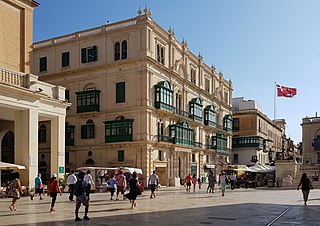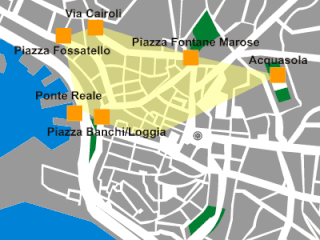
Lombard Bank Malta Plc is one of Malta's major banks, together with Bank of Valletta, HSBC Bank Malta and APS Bank. The Government of Malta through the National Development and Social Fund (NDSF) owns 49.1% percent of the bank. It acquired these shares from the now defunct Cyprus Popular Bank. Over 1,200 shareholders, and investment funds, hold the remaining shares. The Bank has a 71.5% stake in MaltaPost plc., the Maltese national postal operator.

Maltese architecture has its origins in prehistory, and some of the oldest free-standing structures on Earth – a series of megalithic temples – can be found on Malta. The islands were colonized by the Phoenicians and later the Romans, who established the cities of Melite and Gaulos. Although these were substantial settlements and are known to have had numerous temples, churches and palaces, few remains have survived apart from some architectural fragments.

The Inquisitor's Palace, also known as the Sacred Palace, is a palace in Birgu, Malta. It was the seat of the Maltese Inquisition from 1574 to 1798, under the name Palazzo del Sant'Officio. The building was originally constructed as a courthouse known as the Castellania in the early 16th century, but little remains of the original building due to major alterations and renovations carried out in the subsequent centuries.
This page list topics related to Malta.

Royal Naval Hospital Bighi also known as Bighi Hospital, was a major naval hospital located in the small town of Kalkara on the island of Malta. It was built on the site of the gardens of Palazzo Bichi, that was periodically known as Palazzo Salvatore. RNH Bighi served the eastern Mediterranean in the 19th and 20th centuries and, in conjunction with the RN Hospital at Mtarfa, contributed to the nursing and medical care of casualties whenever hostilities occurred in the Mediterranean. The building is now known as Villa Bighi and it houses a restoration unit.

The Messina Palace, also known as Palazzo Messina, is a palace located at No 141 and 141A Strada San Cristoforo in Valletta, Malta. It was built by Fra Pietro La Rocca, Prior of Santo Stefano, towards the end of the 16th century and was once part of a grander palace called Casa Rocca Grande. The property has been occupied by the German-Maltese Circle since 1975, who purchased the building from the Stilon family in 1989.

The Auberge d'Auvergne was an auberge in Valletta, Malta. It was built in the 16th century to house knights of the Order of Saint John from the langue of Auvergne. It became a courthouse in the 19th century, and it remained so until it was destroyed by aerial bombardment in 1941. The site is now occupied by the Courts of Justice building, which was constructed in the 1960s.

The Auberge de Bavière is a palace in Valletta, Malta. It was built as Palazzo Carneiro in 1696, and it was the residence of Grand Master Marc'Antonio Zondadari in the early 18th century. In 1784, it was converted into the auberge for the Anglo-Bavarian langue of the Order of Saint John, and it remained so until the French occupation of Malta in 1798.

Spinola Palace, also known as Spinola House and Villa Spinola, is a palace in St. Julian's, Malta. It was built in the 17th century by Fra Paolo Rafel Spinola, a knight of the Order of St. John, and was enlarged in the 18th century. The later construction was designed by Romano Carapecchia, which is considered a masterpiece, with its back having an elegant clock that is a unique feature to secular Baroque architecture in Malta.

Palazzo Correa, also known as Casa Correa, Correa de Sousa Palace or Palazzo Hompesch, was a 17th-century palace in Valletta, Malta, located in Old Bakery Street. It was built on the designs to architect Carlo Gimach in the Mannerist style, the first in Valletta and very unusual to the period.

Palazzo Ferreria, officially Palazzo Buttiġieġ-Francia, is a palace found near the entrance of Valletta, the capital city of Malta. It was built in the late 19th century. Designed by Architect Giuseppe Bonavia, it makes use of an interesting concept of adding local timber balconies to a design inspired from that of buildings in Italy. It is protected as a Grade 2 national monument.

Palazzo Parisio, sometimes known as Casa Parisio, is a palace in Valletta, Malta. It was built in the 1740s by Domenico Sceberras, and eventually passed into the hands of the Muscati and Parisio Muscati families. It was Napoleon's residence for six days in June 1798, during the early days of the French occupation of Malta. The palace was eventually acquired by the de Piro family, and was later purchased by the Government of Malta. It was used as the General Post Office from 1886 to 1973, then the Ministry for Agriculture, and it now houses the Ministry for Foreign Affairs.

The Banca Giuratale, formerly also known as Banca dei Giurati, the Municipal Palace, the Palazzo della Città, Casa Città and the Consolato del Mare, is a public building in Valletta, Malta. It was built in the 18th century to house the city's administrative council, and it was subsequently used as the General Post Office and the Public Registry. The Banca Giuratale now houses the Ministry for the Economy, Investment and Small Business, and it is officially known as Palazzo Zondadari.

Palazzo Falson, formerly known as Palazzo Cumbo-Navarra, Casa dei Castelletti, and the Norman House, is a medieval townhouse in Mdina, Malta. It was purposely built as a family residence by the Maltese nobility, and it is named after the Falson family. It is presently open to the public as a house-museum with seventeen rooms of historic domestic belongings and a number of antique collections.

The Hostel de Verdelin, also known as Palazzo Verdelin or the Casa delle Colombe, is a palace in Valletta, Malta. It was built in the mid-17th century for the knight Jean-Jacques de Verdelin, and it is an early example of Baroque architecture in Malta. The palace currently houses a police station and a restaurant.
Carlo Gimach was a Maltese architect, engineer and poet who was active in the late 17th and early 18th centuries. Throughout his career, he worked in Malta, Portugal and Rome, and he is mostly known for designing Palazzo Carneiro in Valletta, renovating the Monastery of Arouca in Portugal, and restoring the Basilica of St. Anastasia in Rome. He is known to have written a number of poems and other literary works, but these are all lost with the exception of one cantata which he wrote in 1714.

Admiralty House, formerly known as Casa Miari, Palazzo Don Raimondo and by several other names, is a palace in Valletta, Malta. It was originally built in 1569–70 as two private houses by Fra Jean de Soubiran dit Arafat, a knight of the Order of St. John. The houses were later leased to various owners, including Fra Raimondo de Sousa y Silva, who rebuilt them a single residence between 1761 and 1763.

Maddalena is a neighbourhood in the old town of the Italian city of Genoa. It was one of the six sestieri of ancient Genoa. At present it is part of the Genoa's city Municipio I.

The Chapel of the Immaculate Conception is a Roman Catholic chapel on Bajja 'ta Spinola in St Julian's, Malta. It was built as the church for the Spinola Palace nearby and dedicated to the Immaculate Conception.
Romano Fortunato Carapecchia (1666–1738) was an Italian Baroque architect who was active in Rome, Malta and Sicily. His designs helped transform Malta's capital Valletta into a Baroque city in the first few decades of the 18th century.




















